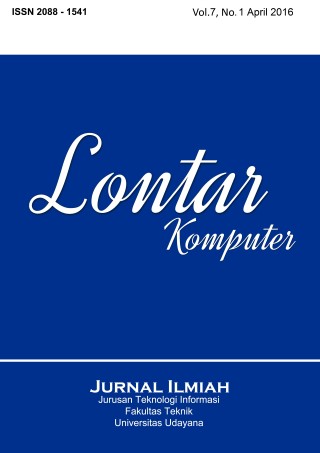Aplikasi Penghitungan Gross Primary Production dari Data Penginderaan Jauh
Abstract
Calculation of Gross Primary Production that utilize remote sensing data is can be done on commercial remote sensing software by manual method. The commercial remote sensing software does not provides a specific feature that allow the user to do the Gross Primary Production calculation. This research is aimed to to build a remote sensing software that can be specifically used to do the Gross Primary Production calculation for Denpasar area. This software accepts remote sensing data as an input, such as satellite image from Landsat 8 OLI and TIRS and metadata file. The formulas and supporting data that required on the Gross Primary Production calculation are implemented on software in order to make an automatic image processing software. There also some additional feature on this software such as automatic data parsing from metadata file, cropping, masking and zoom that could help user to do the Gross Primary Production calculation. The developed software is able to produce information such as Gross Primary Production value that depicted by a figure with color segmentation, area of the segments and mean, minimum and maximum value of the Gross Primary Production.
Downloads
References
[2] Fundamentals of Remote Sensing. Canada: A Canada Centre for Remote Sensing Remote Sensing Tutorial, 2007.
[3] S. Angel and S. Sheppard, The dynamics of global urban expansion. 2005.
[4] A. R. As-syakur, T. Osawa, and I. W. S. Adnyana, “Medium spatial resolution satellite imagery to estimate gross primary production in an urban area.,” Remote Sens., 2010.
[5] J. Weier and D. Herring, “Measuring Vegetation (NDVI & EVI),” 2000. [Online]. Available: https://earthobservatory.nasa.gov/Features/MeasuringVegetation/.
[6] K. Tu, “Modeling Plant-Soil-Atmosphere Carbon Dioxide Exchange Using Optimality Principles,” B.A. University of California at Santa Cruz, 2000.
[7] “NDVI Foundation,” 2015. [Online]. Available: http://phenology.cr.usgs.gov/ndvi_foundation.ph. [Accessed: 04-Apr-2015].
[8] “NASA,” 2014. [Online]. Available: http://landsat.gsfc.nasa.gov/?page_id=7195. [Accessed: 15-Dec-2014].
[9] “Landsat8 Using Product,” 2014.
[10] T. Sakamoto, A. A. Gitelson, B. D. Wardlow, S. B. Verma, and A. E. Suyker, “Estimating daily gross primary production of maize based only on MODIS WDRVI and shortwave radiation data,” Remote Sens. Environ., 2011.
[11] J. B. Bradford, J. A. Hicke, and W. K. Lauenroth, “The relative importance of light-use efficiency modifications from environmental conditions and cultivation for estimation of large-scale net primary productivity,” Remote Sens. Environ., 2005.
[12] “AGS99,” 2015. [Online]. Available: http://a-a-r-s.org/aars/proceeding/ACRS1999/Papers/AGS99-2.htm. [Accessed: 17-Mar-2015].
[13] S. W. Running, R. Nemani, J. M. Glassy, and P. E. Thornton, Modis Daily Photosynthesis (Psn) And Annual Net Primary Production (Npp) Product (Mod17), 3.0. 1999.
[14] Zein and M. T. A. Aziz, “Korelasi Antara Pengukuran dan Indeks Vegetasi (Studi kasus : Taman Nasional Lore-Lindu, Sulawesi Tengah),” Institut Pertanian Bogor, 2009.
[15] S. C. Black, “Estimation of Grass Photosynthesis Rates in Mixed-Grass Prairie Using Field and Remote Sensing Approaches,” University of Saskatchewan Saskatoon, 2006.
[16] L. S. S, “Estimasi Emisi CO2 Dari Kebakaran Hutan,” 2006.
[17] G. L. Morrison, “Solar radiation data for indonesia,” Sol. Energy, 1992.
Keywords
The Authors submitting a manuscript do so on the understanding that if accepted for publication, the copyright of the article shall be assigned to Jurnal Lontar Komputer as the publisher of the journal. Copyright encompasses exclusive rights to reproduce and deliver the article in all forms and media, as well as translations. The reproduction of any part of this journal (printed or online) will be allowed only with written permission from Jurnal Lontar Komputer. The Editorial Board of Jurnal Lontar Komputer makes every effort to ensure that no wrong or misleading data, opinions, or statements be published in the journal.
 This work is licensed under a Creative Commons Attribution 4.0 International License.
This work is licensed under a Creative Commons Attribution 4.0 International License.























